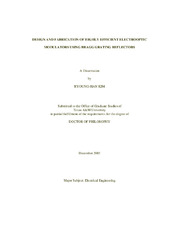| dc.contributor.advisor | Eknoyan, Ohannes | |
| dc.creator | Kim, Ryoung-Han | |
| dc.date.accessioned | 2006-04-12T16:06:35Z | |
| dc.date.available | 2006-04-12T16:06:35Z | |
| dc.date.created | 2005-12 | |
| dc.date.issued | 2006-04-12 | |
| dc.identifier.uri | https://hdl.handle.net/1969.1/3325 | |
| dc.description.abstract | Bragg grating reflectors etched in amorphous silicon overlay films have been integrated with Ti:LiNbO3 optical waveguides. With a 12.5 mm long grating segment and an etch depth of ~ 93 nm in a 105 nm-thick silicon film, a narrow (0.05 nm) spectral bandwidth with a record high transmission dip (> 20 dB) was achieved at a wavelength of ~1542 nm for TE polarization on an x-cut, y-propagating substrate. The reflectance in the channel waveguides is found to be strongly dependent on the depth of the etched grating. The 3-dB bandwidth of 0.05 nm obtained for all tested samples is the smallest reported for waveguides in LiNbO3. The effect of the Bragg waveguide loss factor on the transmittance and reflectance spectra is investigated using a model for contra-directional coupling that includes an attenuation coefficient. The Bragg grating spectral characteristics are exploited to fabricate distributed Bragg feedback modulators (DBFM) and Bragg reflector Fabry-Perot modulators (BFPM). The sharp cut-off in transmission and reflection spectra, which is an inherent characteristic of Bragg grating, was tuned by applying voltage via the linear electrooptic effect, to produce intensity modulation. The Bragg grating based modulators consume less electric power compared to polarization intensity modulators (PIMs). The DBFM demonstrates 1/1.6 times the modulating voltage of a PIM with identical waveguide and electrode structure. The BFPM shows 1/3.3 times the modulating voltage of the PIM. No difference in the frequency response is observed among the three modulators. Comparison of the modulation sensitivity in the linear region indicates that the Bragg grating based modulators provide better sensitivity than that of the PIM with identical waveguide and electrode structure. These results indicate the potential advantage of the Bragg grating based modulators for enhanced modulation efficiency over conventional modulators. Further improvements can be expected from the optimization of the electrode design. | en |
| dc.format.extent | 1672187 bytes | en |
| dc.format.medium | electronic | en |
| dc.format.mimetype | application/pdf | |
| dc.language.iso | en_US | |
| dc.publisher | Texas A&M University | |
| dc.subject | electro-optic | en |
| dc.subject | modulator | en |
| dc.subject | Bragg grating | en |
| dc.subject | fabry-Perot | en |
| dc.subject | intensity modulation | en |
| dc.subject | lithium niobate | en |
| dc.title | Design and fabrication of highly efficient electrooptic modulators using bragg grating reflectors | en |
| dc.type | Book | en |
| dc.type | Thesis | en |
| thesis.degree.department | Electrical and Computer Engineering | en |
| thesis.degree.discipline | Electrical Engineering | en |
| thesis.degree.grantor | Texas A&M University | en |
| thesis.degree.name | Doctor of Philosophy | en |
| thesis.degree.level | Doctoral | en |
| dc.contributor.committeeMember | Chang, Kai | |
| dc.contributor.committeeMember | Cote, Gerald | |
| dc.contributor.committeeMember | Taylor, Henry F. | |
| dc.type.genre | Electronic Dissertation | en |
| dc.type.material | text | en |
| dc.format.digitalOrigin | born digital | en |


